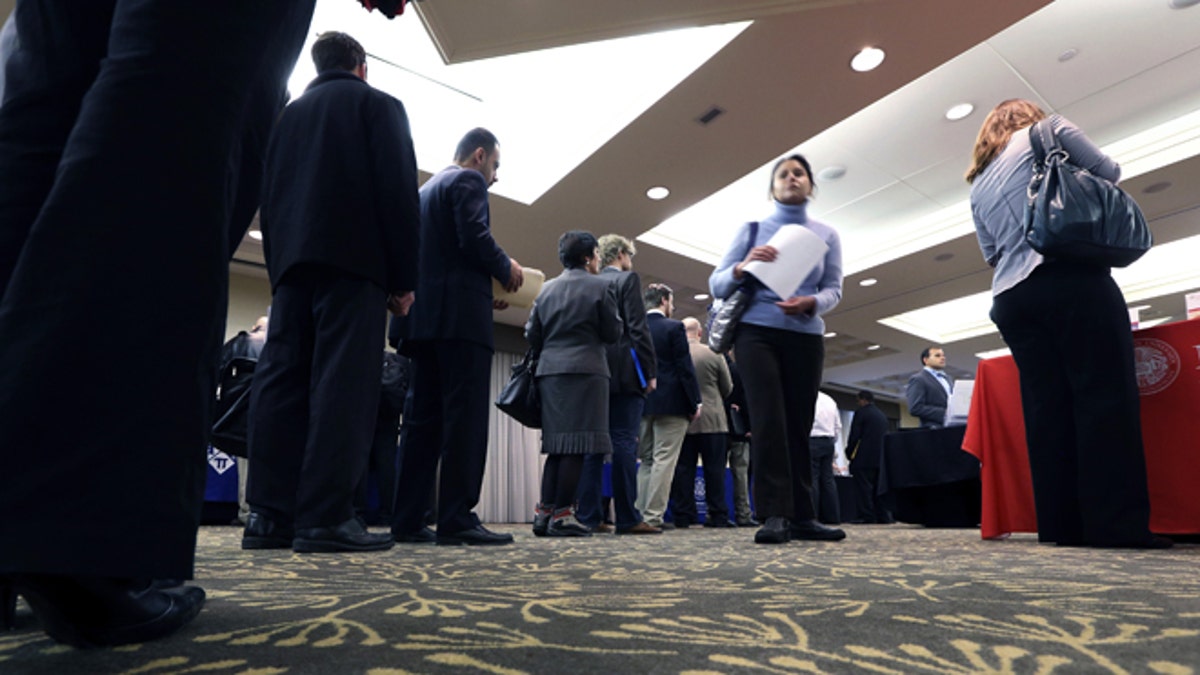
Feb. 25, 2013: Job seekers line up to speak with a State Department employee about job opportunities in the federal government during a job fair in Boston. (AP)
The U.S. economy is teetering further on the edge of recession, with revised numbers showing economic growth clocking in at an anemic rate at the end of 2012.
Analysts expect the numbers to pick up this quarter, but a succession of revisions for the final months of last year give a bleak picture. The Commerce Department estimated Thursday that the gross domestic product, the total output of goods and services, grew at an annual rate of 0.4 percent in the October-December quarter. That was just slightly better than the previous estimate of 0.1 percent, and an estimate before that showing the economy actually contracted in that period.
Technically, the economy has been in recovery since 2009. But for many, it doesn't feel like it -- recent public opinion surveys reflect the dour mood several years after the last recession's end.
A Pew Research Center survey earlier this month found 33 percent reporting that they hear "mostly bad news" about the economy, with just 7 percent saying they hear good news. Fifty-eight percent said it was "mixed."
On the job front, the public mood was worse. Roughly 45 percent said they were hearing mostly bad news, while just 15 percent said they heard mostly good news.
The bright spots at the moment appear to be in the financial markets, where the Dow is still riding a surge, and in real estate. Sales of previously occupied homes rose in February to the highest level in nearly three years, while builders broke ground on more houses and apartments. Annual home prices jumped in January by the most since June 2006, according to a closely watched measure.
Despite the recent slack, analysts think the economy is now growing at a rate of around 2.5 percent in the current January-March quarter, which ends this week. The government will release its first look at first quarter growth on April 26.
Steady hiring has kept consumers spending this year. And a rebound in company stockpiling, further gains in housing and more business spending also likely drove faster growth in the first quarter.
But the 0.4 percent growth rate for the gross domestic product was the weakest quarterly performance in almost two years and followed a much faster 3.1 percent increase in the third quarter. The fourth quarter was hurt by the sharpest fall in defense spending in 40 years.
For all of 2012, the economy grew 2.2 percent after a 1.8 percent increase in 2011 and a 2.4 percent advance in 2010. Since the recession ended in mid-2009, the economy has been expanding at sub-par rates as a string of problems from higher gas prices to Europe's debt crisis have acted as a drag on the U.S. economy.
The economy continues to face headwinds. Though lawmakers averted the full brunt of the so-called fiscal cliff at the beginning of the year -- which would have been the double-blow of sweeping tax hikes and automatic spending cuts -- some of those provisions ended up going into effect eventually.
A payroll tax cut ended at the beginning of 2013, and taxes rose for some top earners. Then the automatic spending cuts known as sequester took effect on March 1 despite last-minute attempts to avert them.
The Congressional Budget Office has estimated that the combination of tax increases and spending cuts could trim economic growth this year by about 1.5 percentage points. The CBO is predicting just 1.5 percent growth for 2013.
Employers have still added an average of 200,000 jobs a month since November. That helped lower the unemployment rate in February to 7.7 percent, a four-year low.
But weekly numbers released Thursday showed the number of Americans seeking unemployment benefits jumped by 16,000 last week, the second straight weekly increase.
The Associated Press contributed to this report.




